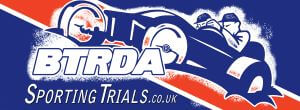Hooking up the Grip! by Julian Fack
By Julian Fack 20.12.22
Have you ever wondered why it is that some drivers appear to climb effortlessly up a trials section while you always appear to stop on the steep bit? It is all about gathering exactly the right amount of speed at the right time and in the right place, and the bleeding it off steadily as you – literally – float up the steep bit with ever decreasing throttle. It is one of the most important skills in trials driving, and for most people it is counter-intuitive in the extreme.
During BTRDA Training Days we stress that there are only two basic techniques, Trickle and Blast, but the two superb events recently, The Johnson and The Gloucester, remind me that trickle is not really a single technique, but rather it can be thought of as two separate skills.
Normal trickle brings to mind constant speed driving using just enough throttle to maintain forward motion, often on grass, heather, bracken and similar natural surfaces. The reason we do this is to avoid breaking the stems and releasing the sap (nature’s grease) onto our tyres. Just to emphasize how powerful the grip provided by trickling is, how often have you failed when blasting only to drive away gently after your card has been marked?
As a subset of trickle the technique of Gathering Momentum can be a vital tool in yourarsenal, and this is what was needed on several sections at both the Johnson and Gloucester. It was not possible to make some climbs without it, neither standard trickle not blasting worked. The method requires gentle (but not too gentle) acceleration without any wheelspin, in order to gather enough speed to climb the next slope (which simply does not have enough grip). Often quite high speeds can be used if there is enough room between the poles. It is most useful where there is a lesser gradient leading to a steeper part, as was the case on several sections at the Gloucester. You should of course use every bit of ground available to you so you have space to gather momentum, rather than turning early as I saw several rookies do.
To do this requires very careful use of the throttle, and possibly a little gentle fiddle brake if there is a cross camber, although it is mostly achieved without fiddle brake use. What you are trying to do is to deploy the maximum torque to your wheels that the terrain will allow, without any spin at all. As soon as you spin up (even slightly) you have lost the traction that is accelerating the car. This is not easy and requires a very smooth throttle action and a steady (but not too steady) right foot. Remember “Grass is Grip” so always aim for undamaged grass rather than sticking to the line where the grass has been ripped up by
previous cars.
Luckily it is not too difficult to practice this technique. You can check the grip level as you drive between sections, and as you drive around the site. See how much throttle you can use without any trace of spin, you will be surprised how the car can accelerate, even on slippery patches. You only need a few metres, there is no need to achieve any speed, you are only trying to assess how much throttle the grip level can support.
Having got the initial speed on a section you will usually back off a little without slowing down much, just maintaining the momentum, to make sure you do not spin the wheels inadvertently. You may find the technique easier using a higher gear, because this reduces the torque, and it is easier to drive fast with a small throttle opening. The extra speed will allow your engine to pull the higher gear, but you will need to think ahead to see if you require a lower gear higher up the section. If so look for opportunities to change down, such as a downhill or level bit of ground. It is generally not possible to drop down a gear under load whilst climbing without coming to a halt.
Whereas the technique of accelerating where you are able is a universal trials skill that can be applied to any site, the speed you are aiming to achieve can vary radically. At The Gloucester this December you should have been aiming to gain as much as 10mph on some parts of some sections, whereas at Gale Hall in Cumbria sometimes as little as 1 or 2mph is adequate.
Julian Fack.
